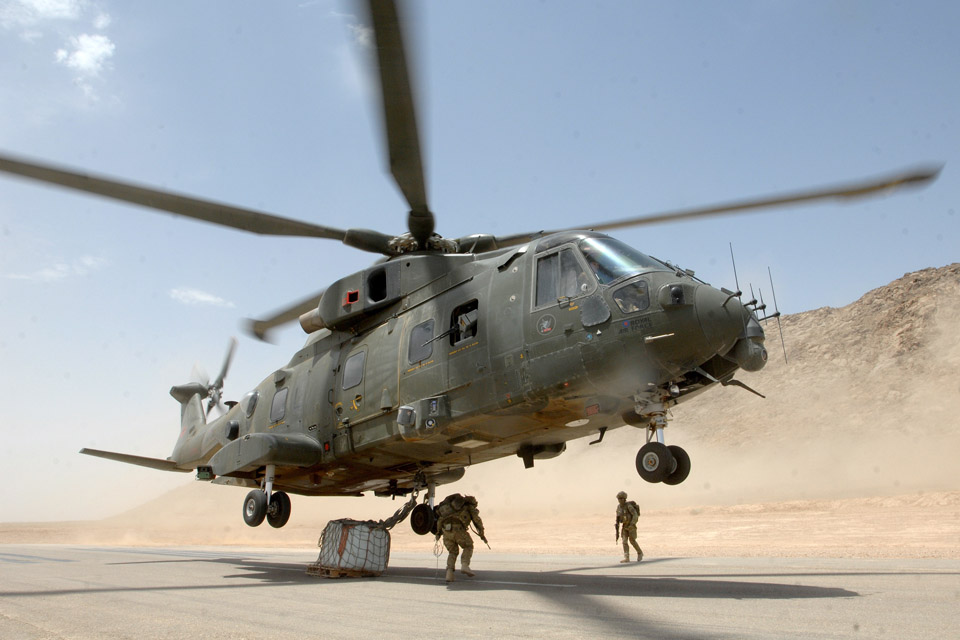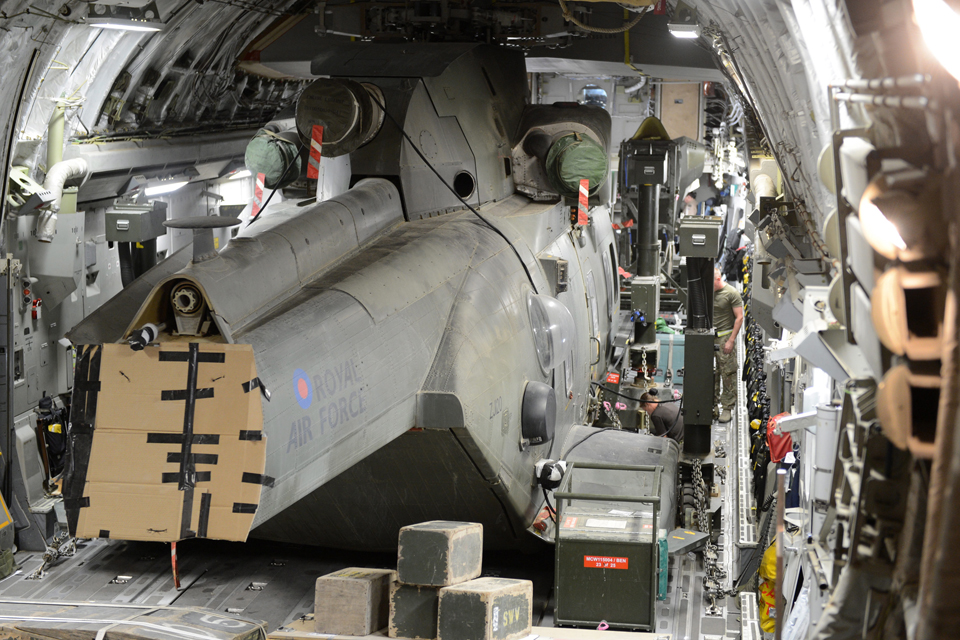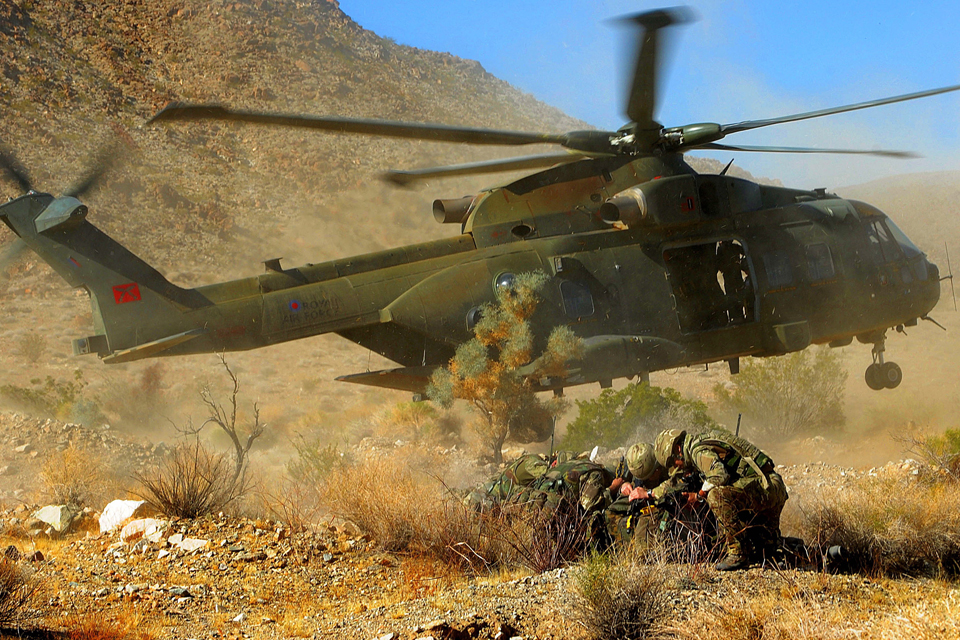UK Merlins' Afghanistan mission over
The UK's Merlin helicopter fleet has concluded operations in Afghanistan after providing nearly 4 years of continuous front line support.
![A British Merlin helicopter in the skies over Afghanistan (library image) [Picture: Sergeant Steve Blake, Crown copyright]](https://assets.publishing.service.gov.uk/media/5a617fcd40f0b60ab9a7f273/s300_Emb_45153503.jpg)
A British Merlin helicopter in the skies over Afghanistan (library image)
The Merlins have flown more than 18,000 hours in the dust and heat of Helmand – moving more than 7,900 tonnes of kit and stores and transporting over 130,000 personnel during that time.
In theatre, the Merlin has primarily been used as a troop transporter, sharing that role with the workhorse Chinook helicopters since 2009.
Orderly drawdown

A Merlin helicopter is packed and secured into an RAF C-17 Globemaster transport aircraft [Picture: Sergeant Barry Pope, Crown copyright]
As the UK military hands over security responsibility to Afghan forces, the number of UK bases in Helmand province has fallen – from 137 in 2010 to 11 this year, meaning fewer helicopters are needed to support them.
The requirement for helicopters in theatre has fallen by around 40% in the past 3 years. In 2010, helicopter support hours totalled around 2,300 a month – a figure that has now fallen to approximately 1,350 hours a month. As a result, the Merlin fleet and its crews can now be returned to the UK to prepare for potential future roles.
The conclusion of Merlin operations in Afghanistan is the latest manifestation of the changing role of British and other international forces as the process of transition to an Afghan security lead continues apace. As Prime Minister David Cameron has already announced, the number of British troops in Afghanistan will fall to around 5,200 by the end of this year from a peak of 9,500 in 2012.
Defence Secretary Philip Hammond said:
The Afghan National Security Forces are growing in capability, and their success is driving the transition and redeployment process. Afghan security forces are on track to take on responsibility for all operations across the country this summer and their success means we have been able to reduce the number of our bases – with consequently fewer helicopters needed to serve them.
The Merlin fleet has served with distinction in Afghanistan, but our role has changed significantly in recent months and returning the Merlin fleet now is a key element of our orderly drawdown from Afghanistan.
British forces on the ground still retain appropriate capability to move personnel and equipment by air as required, as well as support from our Afghan and ISAF colleagues. Our troops will continue to be resourced properly for the roles they are conducting, and our drawdown of equipment will be done in a way that does not compromise our ongoing operations or put our personnel at additional risk.
Tireless support in a demanding environment

An RAF Merlin helicopter takes off with an underslung load in Afghanistan (library image) [Picture: Sergeant Andy Reddy, Crown copyright]
Group Captain Frazer Nicholson, Commander of the Joint Aviation Group, based in Camp Bastion, Afghanistan, said:
The Merlin helicopters have proven to be a capable air asset that have tirelessly moved personnel and equipment in a really demanding environment.
Camp Bastion is nearly 3,000 feet above sea level, dusty, and over 40 degrees in the summer. That environment is incredibly tough on all helicopters but the Merlins have fared well.
Squadron Leader Kevin Harris, Officer Commanding 1419 Flight, Camp Bastion Merlin Detachment, said:
The aircrew and engineers have worked tirelessly to operate the Merlins in support of UK forces in Afghanistan and it has been an immense privilege to have commanded such a fine group of young men and women.
The aircrew will return to RAF Benson in Oxfordshire where they will take some well-earned leave and the engineers will remain in Afghanistan to dismantle the aircraft for their onward transportation back to the UK.
The Merlins will undergo an extensive programme of maintenance and cleaning before being packed up, ensuring they return to the UK in good order.

A Merlin helicopter is packed and secured into an RAF C-17 Globemaster transport aircraft [Picture: Sergeant Barry Pope, Crown copyright]
Engineers in Camp Bastion are now hard at work preparing the Merlin helicopters for their journey back to the UK. Each helicopter will have its rotor blades and tail removed and will undergo a full ‘bio-wash’ to remove dust and insects before being loaded onto a wheeled transport unit that will be driven on board a huge RAF C-17 Globemaster transport aircraft for the trip home.
Future amphibious role

A Merlin helicopter inserts Royal Marines into the Mojave Desert during a training exercise in the USA (library image) [Picture: Petty Officer (Photographer) Sean Clee, Crown copyright]
After their return to RAF Benson the Merlins will join the rest of the Merlin Force in the ongoing transition of the aircraft to Joint Helicopter Command’s Royal Navy Commando Helicopter Force.
The maritime force is trained and equipped for expeditionary joint operations and the Merlins will be prepared for their new role in supporting amphibious operations. RAF personnel are currently training the Royal Navy aircrew and engineers on the operation and maintenance of the technologically advanced helicopter, which is due to move to a maritime role by 2015.